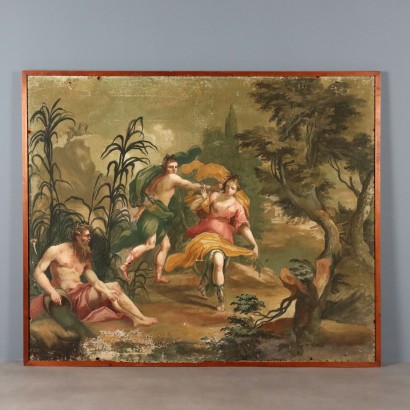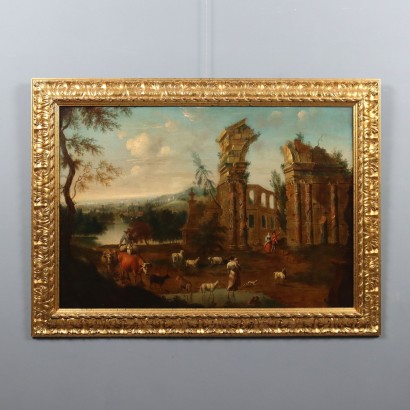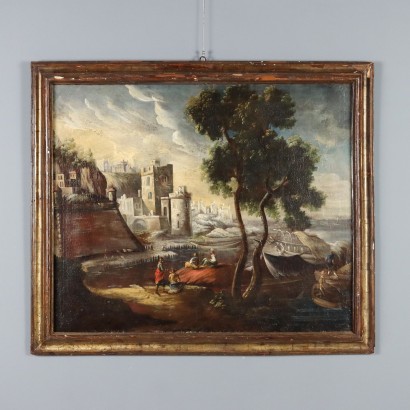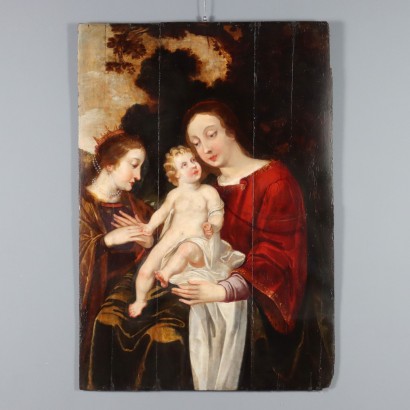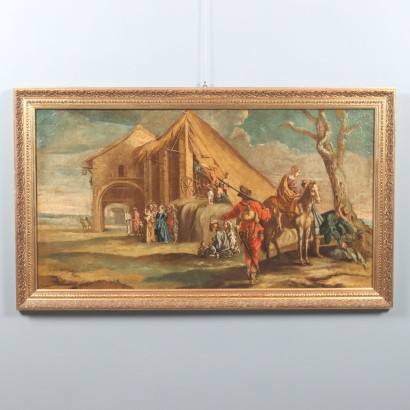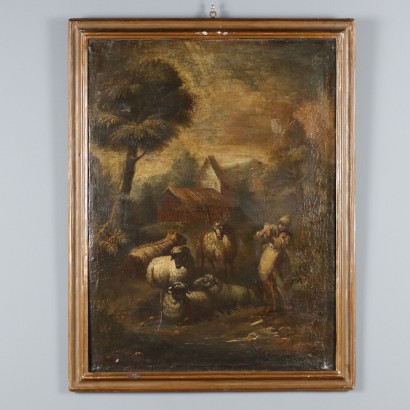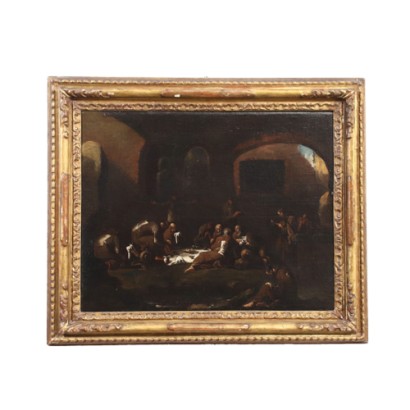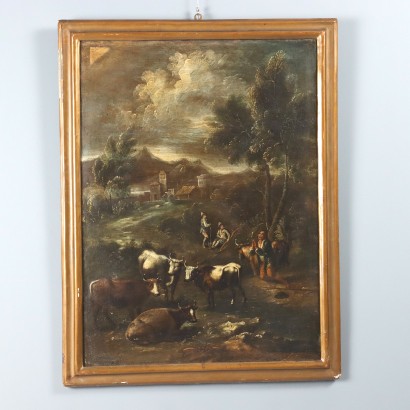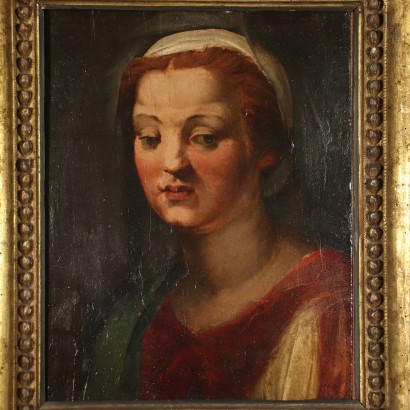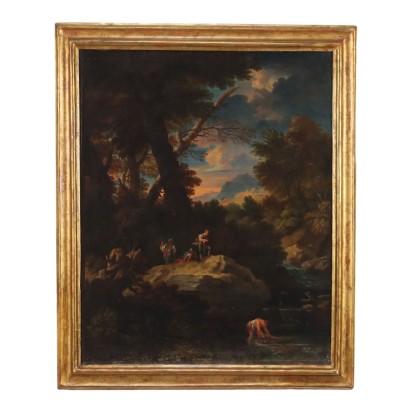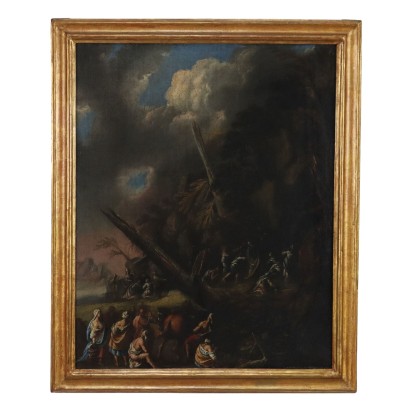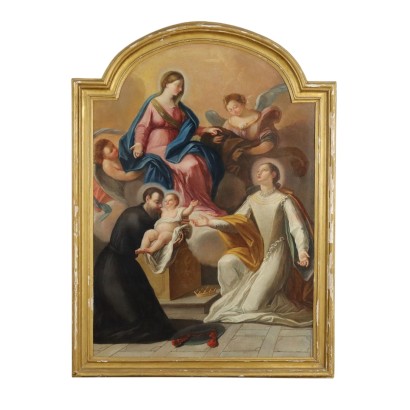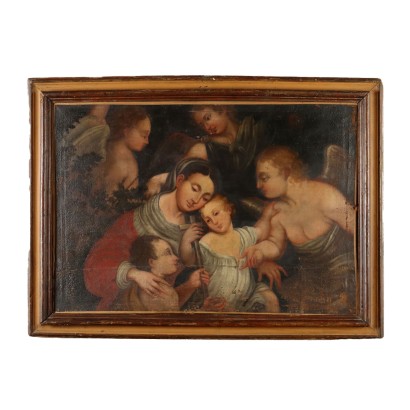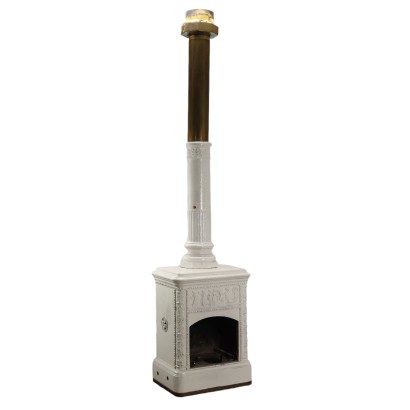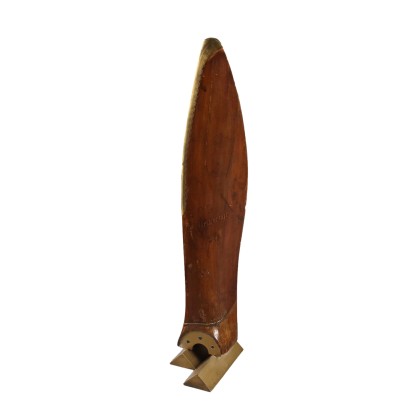Apollo and Daphne Antique Painting Oil on Canvas XVIII Century
Features
Artwork title: Apollo e Dafne
Artistic school: Tuscan School
Age: 18th Century / 1701 - 1800
Subject: Allegorical/Mythological Subject
Origin: Italy
Artistic technique: Painting
Technical specification: Oil on Canvas
Description : Apollo e Dafne
Oil on canvas. 18th-century Tuscan School. The large scene tells the tragic story of Apollo and Daphne, recounted in Ovid's Metamorphoses. According to myth, the god Apollo, having mocked Cupid, is struck by him with an arrow of love, causing him to fall in love with the nymph Daphne, who is instead struck by a leaden arrow, capable of ending their love. Apollo, struck by the arrow, falls madly in love with Daphne and runs toward her, but the nymph rejects the god and runs away. To avoid being captured, Daphne asks her father Peneus, eponymous god of the river Peneus, to transform her so she will not have to submit to Apollo. Peneus listens to her request, and when Apollo is about to seize her, Daphne transforms into a laurel tree, a plant that from that moment on becomes sacred to the god. The work displays some similarities to the pictorial style of Giuseppe Zocchi (1711-1767), whom the artist likely drew upon in particular in the depiction of trees and vegetation. The canvas features several paint losses, especially in the lower left corner, and a series of holes (of varying sizes along the edges and in the center) caused by previous nails placed for reinforcement. Framed.
Product Condition:
The item is in good condition, with minor signs of wear. We try to present the item's actual condition as accurately as possible with the photos. If any details are unclear from the photos, the description will apply.
Frame Size (cm):
Height: 143,5
Width: 173,5
Depth: 3,5
Artwork dimensions (cm):
Height: 140
Width: 170
Additional Information
Artistic school: Tuscan School
Age: 18th Century / 1701 - 1800
18th Century / 1701 - 1800Subject: Allegorical/Mythological Subject
Artistic technique: Painting
La pittura è l'arte che consiste nell'applicare dei pigmenti a un supporto come la carta, la tela, la seta, la ceramica, il legno, il vetro o un muro. Essendo i pigmenti essenzialmente solidi, è necessario utilizzare un legante, che li porti a uno stadio liquido, più fluido o più denso, e un collante, che permetta l'adesione duratura al supporto. Chi dipinge è detto pittore o pittrice. Il risultato è un'immagine che, a seconda delle intenzioni dell'autore, esprime la sua percezione del mondo o una libera associazione di forme o un qualsiasi altro significato, a seconda della sua creatività, del suo gusto estetico e di quello della società di cui fa parte.Technical specification: Oil on Canvas
The oil painting is a painting technique using powder pigments mixed with bases in inert and oils.Other customers have searched:
Se sei un appassionato d'arte, non perderti i nostri approfondimenti sul Blog Arte Di Mano in Mano e su FineArt by Di Mano in Mano - Arte:
Leggi di più
Ecco alcuni tra i principali articoli:Vedute
Falsi nell'arte antica
Un messaggio di fiducia per ripartire
La potenza espressiva dell'arte figurativa etiope
Breve Storia del Collezionismo
Giorgio Upiglio, maestro dei libri d'artista
Matthias Withoos detto "Calzetta bianca"
San Rocco pensaci tu - Classic Monday
Dai un'occhiata alle nostre rubriche di divulgazione sull'arte:
Epoche
Lavorazioni e tecniche
Mostre ed Eventi
Protagonisti
Se sei appassionato di pittura antica, con tutta probabilità gusterai le schede di questi stupendi quadri:
"Dio parla a Noè dopo il diluvio", Jacopo da Ponte, detto il Bassano, seconda metà XVI secolo
Crocifissione, maestro della misericordia dell'accademia, terzo quarto del XIV secolo
Erminia incontra i pastori, Camillo Gavassetti, Seconda metà anni Venti del XVII Secolo
Eroine dell'antichità, Francesco Conti, XVIII secolo
Hieronymus III Francken, La Negazione di Pietro, XVII secolo
Jefte e la figlia, Girolamo Forabosco e aiuti, XVII secolo
L'Accademia di Platone, piccolo arazzo, fine XVII - inizio XVIII secolo
Maddalena e San Giovanni Battista
Natura Morta, Bartolomeo Arbotori, XVIII secolo
Sacra Famiglia con San Giovannino, Bartolomeo Ramenghi, scuola di, prima metà XVI secolo
Testa Femminile, Andrea del Sarto, ambito di, post 1522
Uva, fichi, melagrana e pesche su un capitello - Maximilian Pfeiler, primo quarto XVIII secolo
Sapevi che l'arte può essere anche un ottimo investimento (e non solo per grandi portafogli)?
L'Arte tra Collezionismo e Investimento
FineArt: Arte come investimento
Product availability
The product can be seen at Cambiago
Immediate availability
Ready for delivery within 2 working days from ordering the product.

